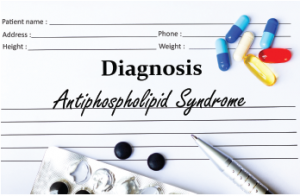
Marcelo Ricardo Daros/shutterstock.com
CHICAGO—Doruk Erkan, MD, MPH, a rheumatologist at the Hospital for Special Surgery and Weill Cornell Medicine in New York City, described recent developments in the field of antiphospholipid syndrome (APS) to the rheumatologists gathered for the ACR’s State-of-the-Art Clinical Symposium in April.
He introduced APS as a “field with limited data and lots of controversies,” although, he added that recently a significant amount of collaborative effort has been made to advance the field. For example, he discussed an international multidisciplinary effort underway to develop new APS classification criteria. The new criteria are being created using methodology endorsed by the ACR and European League Against Rheumatism (EULAR). Dr. Erkan said he hopes the APS classification criteria will be updated in the next few years.
Thrombosis Risk in aPL-Positive Patients
In addition, experts are creating improved risk calculation/stratification protocols for patients who test positive for antiphospholipid antibodies (aPL). This is important because the clinical manifestations of aPL occur on a spectrum and not every positive aPL result is clinically significant. Likewise, thrombosis is multifactorial, and many factors in addition to aPL can influence the thrombosis risk in aPL-positive patients.
So the question becomes: What is a clinically significant aPL profile? The most basic answer to this question is that, although low-titer anti-cardiolipin antibody (aCL) or anti-β2-glycoprotein-I (aβ2GPI) levels during infections are common, persistently elevated aPL is noteworthy. Thus, aCL or aβ2GPI titers that are less than 20 U are rarely clinically significant, but titers that are moderate to high (≥ 40 U) and/or positive lupus anticoagulant (LA) tests are associated with an increased risk of thrombosis.
In particular, the report from the 14th International Congress on Antiphospholipid Antibodies Task Force published in Autoimmunity Reviews in 2014 described APS laboratory diagnostic and trends. It stated that “aPL should not only be considered as diagnostic markers, but also as risk factors for clinical events.”1 The hope is that aPL and other risk factors can ultimately be compiled into a calculator that can be used to predict the risk of thrombosis.
One such effort to calculate thrombosis risk using aPL profile and selected cardiovascular disease risk factors is the Global APS Score (GAPSS), which was verified in four steps.2 In the first step, patients with systemic lupus erythematosus (SLE) were assigned weighted points based on risk factors identified by multivariate analysis. The researchers noted that the scoring protocol awarded higher scores to patients with thrombosis and pregnancy morbidity. In the second step, the scores were validated in patients with SLE. The third step involved a prospective assessment of patients with SLE; during this step, the researchers found that those with more than a three-point increase during the follow-up were most reliably at increased risk for vascular events. Finally, in step four, researchers assessed patients with primary APS (PAPS) and found a higher score in patients with thrombosis relative to those with pregnancy morbidity.
Rheumatologists may soon be able to leverage several new aPL tests in APS diagnosis and risk calculation. The most promising of these is the test for phosphatidylserine-dependent antiprothrombin antibodies. Other tests, such as for antibodies to domain I of β2GPI, are being investigated. Unfortunately, there are not yet any official recommendations for these.
Prevention
Dr. Erkan also updated the audience on primary and secondary thrombosis prevention, noting, “It’s easy because there’s no update.” He reiterated that, in the case of primary thrombosis prevention, risk stratification is critical. The ideal strategy should stratify risk based upon aPL profile, age, traditional cardiovascular risk factors, venous thrombosis risk factors and systemic autoimmune disease. Any non-aPL thrombosis risks should be investigated regularly and eliminated and/or treated rigorously.
Although the effectiveness of low-dose aspirin is not supported by randomized controlled data, Dr. Erkan explained that “aspirin can be effective, based on all retrospective studies.” Therefore, he recommends that general cardiovascular disease guidelines play a role in decision making for low-dose aspirin therapy. He added, however, “In my practice, aspirin is not an automatic reaction to a positive aPL result.”
Likewise, when it comes to secondary thrombosis prevention, rheumatologists should stratify risk and regularly investigate non-aPL thrombosis risk factors, eliminating and/or treating them rigorously. Randomized, controlled trials do not support the use of high-intensity (international normalized ratio 3–4) anticoagulation for these patients; however, it may be considered in patients at very high risk of thrombosis.
Dr. Erkan also pointed out that the necessity of lifelong anticoagulation for every APS patient is not well established; discontinuation of anticoagulation may be considered in APS patients with a single venous thrombosis occurring with a clear thrombosis trigger, such as birth control pills.
CAPS Guideline
Dr. Erkan provided the audience with an update on the clinical practice guideline recently submitted—but not yet published—on the diagnosis and management of catastrophic APS (CAPS), a project funded by the European Rare Practices Initiative and guided by methodologists from McMaster University, Canada. He called CAPS “a very difficult topic” and emphasized the importance of early and aggressive treatment. Standard treatment includes anticoagulation plus corticosteroids plus intravenous immunoglobulin (IVIG)/plasma exchange, possibly with rituximab.
DOACs & More
In the remainder of his talk, Dr. Erkan discussed the role of direct oral anticoagulants (DOACs), such as rivaroxaban, apixaban, adoxaban and dabigatran, in the management of APS. He shared the 15th International Congress on aPL Task Force on Treatment Trends Recommendation, which was that “insufficient evidence exists to make recommendations at this time regarding DOAC use in APS.” Thus, Dr. Erkan recommended against the use DOACs in APS until the results of controlled trials using clinical outcome measures are available.
He also discussed some of the newer immunosuppressive approaches to treatment that focus on complement and mechanistic target of rapamycin (mTOR) pathway inhibition.
He concluded his talk by briefly discussing the 15th International Congress on Antiphospholipid Antibodies, which met in September 2016. He noted that the abstract booklet is free to download.
Lara C. Pullen, PhD, is a medical writer based in the Chicago area.
Free Resource
For more information on APS, download the free iBook, Antiphospholipid Syndrome. A collaborative project of the Hospital for Special Surgery, N.Y., and Nancy-Lorraine University, Nancy, France, Antiphospholipid Syndrome was developed primarily to help medical students better understand the spectrum of aPL-related clinical problems and receive proper education in the diagnosis and management of APS. The authors are Laurent Phialy, Stéphane Zuily and Doruk Erkan.
References
- Bertolaccini ML, Amengual O, Andreoli L, et al. 14th International Congress on Antiphospholipid Antibodies Task Force. Report on antiphospholipid syndrome laboratory diagnostics and trends. Autoimmun Rev. 2014 Sep;13(9):917–930.
- Sciascia S, Bertolaccini ML. Thrombotic risk assessment in APS: The Global APS Score (GAPSS). Lupus. 2014;23(12):1286–1287.
